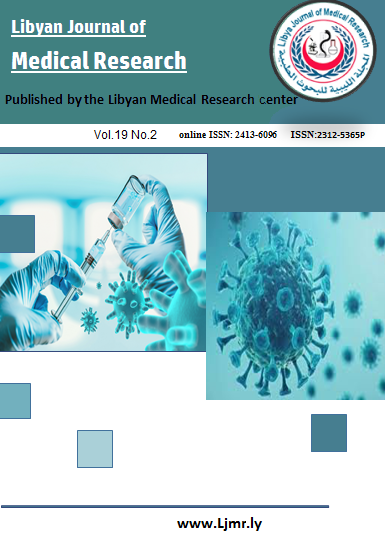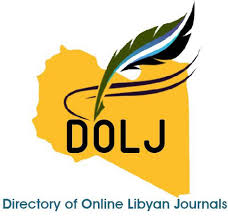Assessment of the case report of an Angelman Syndrome child in Janzour City, Libya
DOI:
https://doi.org/10.54361/LJMR.19.2.24Keywords:
Angelman syndrome, proximal long arm, hypotonia, hyperreflexia, ataxia, child, LibyaAbstract
Background: Angelman syndrome (AS) is a genetic neurological disorder that was first described in 1965 by Dr. Harry Angelman Angelman syndrome is a rare neurogenetic disorder that is characterized by microcephaly, severe intellectual deficit, speech impairment, epilepsy, EEG abnormalities, ataxic movements, tongue protrusion, paroxysms of laughter, abnormal sleep patterns, and hyperactivity, To assess the clinical subject in individual with AS, we retrospectively analyzed medical records of 5-yers old male seen at the pediatric physical therapy Clinic at Altahady Center for Intensive Physical Therapy for Children. Janzour City. Case Presentation: We present the case of a 5-year-old male patient from Janzour City, Libya, diagnosed with Angelman syndrome, with deletions of the proximal long arm of chromosome 15q11.2–q13 in individuals with Angelman syndrome. The first-line clinical diagnostic test for patients suspected of having Angelman syndrome is DNA methylation testing, including neurological manifestations including include microcephaly, seizure disorder, ataxia, muscular hypotonia with hyperreflexia, and motor delay. Psychomotor delay is evident by 6 months of age, and can be associated with feeding difficulties and muscular hypotonia.This review finding was, a multidisciplinary approach is imperative for managing patients with AS. Parental counseling and genetic advice are crucial for families and caregivers. Conclusion: Physicians should consider rare syndromes such as AS in children or adults with neurodevelopmental delay. Noting clinical presentation is very important; extensor and flexor spasms are not typically described as seizure types in AS because clinical suspicions play a crucial role in choosing the required laboratory tests. On the other hand, a multidisciplinary approach is necessary for genetic syndromes like AS because they influence all aspects of patients’ lives.
Downloads
References
1. Buiting, K., Williams, C., & Horsthemke, B (2016) Angelman syndrome — insights into a rare neurogenetic disorder. Nature Reviews Neurology, 12(10), 584–593.
2. Clayton-Smith, J. (2003)Angelman syndrome: a review of the clinical and genetic aspects. Journal of Medical Genetics, 40(2), 87–95.
3. Matsuura, T. et al. (1997 ) De novo truncating mutations in E6-AP ubiquitin-protein ligase gene (UBE3A) in Angelman syndrome. Nat. Genet. . 15, 74–77.
4. Tan, W. H. et al.) (2011Angelman syndrome: mutations influence features in early childhood. Am. J. Med. Genet , A 155A, 81–90.
5. Ruchi P, Alena E , Rong M , Melinda P , Michelle B , DeniseQ , Kathleen A , Suma P S (2022) Atypical presentation of Angelman syndrome with intact expressive language due to low‐level mosaicism Mol Genet Genomic Med 4;10(10):e2018
6. Vu, T. H. & Hoffman, A. R.) (1997Imprinting of the Angelman syndrome gene, UBE3A, is restricted to brain. Nat. Genet. 17, 12–13.
7. Williams CA, Angelman H, Clayton-Smith J, Driscoll DJ, Hendrickson JE, Knoll JH, Magenis RE, Schinzel A, Wagstaff J, Whidden EM, et al ( 2006) Angelman syndrome updated consensus for diagnostic criteria. Am. J. Med. Genet. . A 140A, 413–418.
Downloads
Published
Issue
Section
License
Copyright (c) 2025 Sedik A Abokdeer, Mohammed S Ghania (Author)

This work is licensed under a Creative Commons Attribution-NonCommercial-NoDerivatives 4.0 International License.
Open Access Policy
Libyan journal of medical Research (LJMR).is an open journal, therefore there are no fees required for downloading any publication from the journal website by authors, readers, and institution.
The journal applies the license of CC BY (a Creative Commons Attribution 4.0 International license). This license allows authors to keep ownership f the copyright of their papers. But this license permits any user to download , print out, extract, reuse, archive, and distribute the article, so long as appropriate credit is given to the authors and the source of the work.
The license ensures that the article will be available as widely as possible and that the article can be included in any scientific archive.
Editorial Policy
The publication of an article in a peer reviewed journal is an essential model for Libyan journal of medical Research (LJMR). It is necessary to agree upon standards of expected ethical behavior for all parties involved in the act of publishing: the author, the journal editorial, the peer reviewer and the publisher.
Any manuscript or substantial parts of it, submitted to the journal must not be under consideration by any other journal. In general, the manuscript should not have already been published in any journal or other citable form, although it may have been deposited on a preprint server. Authors are required to ensure that no material submitted as part of a manuscript infringes existing copyrights, or the rights of a third party.
Authorship Policy
The manuscript authorship should be limited to those who have made a significant contribution and intellectual input to the research submitted to the journal, including design, performance, interpretation of the reported study, and writing the manuscript. All those who have made significant contributions should be listed as co-authors.
Others who have participated in certain substantive aspects of the manuscript but without intellectual input should only be recognized in the acknowledgements section of the manuscript. Also, one of the authors should be selected as the corresponding author to communicate with the journal and approve the final version of the manuscript for publication in the LJMR.
Peer-review Policy
- All the manuscripts submitted to LJMR will be subjected to the double-blinded peer-review process;
- The manuscript will be reviewed by two suitable experts in the respective subject area.
- Reports of all the reviewers will be considered while deciding on acceptance/revision or rejection of a manuscript.
- Editor-In-Chief will make the final decision, based on the reviewer’s comments.
- Editor-In-Chief can ask one or more advisory board members for their suggestions upon a manuscript, before making the final decision.
- Associate editor and review editors provide administrative support to maintain the integrity of the peer-review process.
- In case, authors challenge the editor’s negative decision with suitable arguments, the manuscript can be sent to one more reviewer and the final decision will be made based upon his recommendations.













